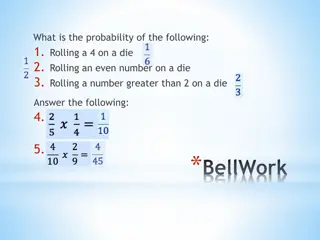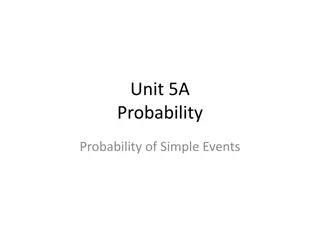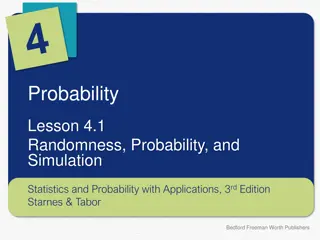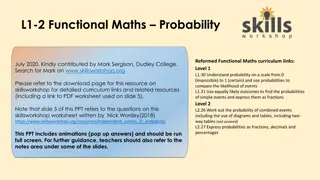Understanding Probability in Psychological Research
This article delves into the use of probability in psychological research, covering key concepts such as random variables, probability functions, and distribution functions. It explains fundamental ideas like random experiments, sample spaces, types of sample spaces, events, and the formal approach to probability. Theorems and conditional probability are also discussed, providing a comprehensive overview of how probability is utilized in psychological studies.
Download Presentation

Please find below an Image/Link to download the presentation.
The content on the website is provided AS IS for your information and personal use only. It may not be sold, licensed, or shared on other websites without obtaining consent from the author. Download presentation by click this link. If you encounter any issues during the download, it is possible that the publisher has removed the file from their server.
E N D
Presentation Transcript
Theme 7. Use of probability in psychological research 1. Introduction. 2. Random variables. 3. Probability function and distribution function.
1. Introduction Main preliminary concepts Random experiment: Any operation whose outcome can not be predicted with certainty For example, when rolling a dice, RTs when performing a task, the number of accidents in a given weekend. Sample space (E): The set of all possible outcomes of a random experiment. For example, if we throw a dice, there are 6 possible outcomes.
Depending on the number of elements in the sample space we can distinguish 3 types of sample spaces: discrete finite sample space. It consists of a finite number of elements. (e.g., throwing a dice) infinite discrete sample space. It consists of a countable infinite number of elements. (E.g., rolling a die until a "6 ) continuous sample space. It consists of an uncountable infinite number of elements. (E.g. possible number of achievable points in an experiment of "throwing an arrow to a target")
Event: It is any subset of a sample space Event types (according to the number of elements in the sample space): Single event (or elemental), that is consisting of a single element Compound event, consisting of two or more elements Sure event, consisting of all elements of the sample space Impossible event that event not composed of any element of the sample space
Probability: FORMAL APPROACH Axioma 1. The probability of the sure event is 1 ( ) 1 P E = Axioma 2. The probability of any event is not negative S ( ) P S 0 Axioma 3. The probability of the union of two events (S1 and S2), mutually exclusive, is the sum of their probabilities = + ( ) ( ) P S ( ) P S S P S 1 2 1 2
Theorem. The probability of binding a countable infinite set of mutually exclusive events is equal to the sum of their probabilities = + ) ... + + ( ... ) ( ) P S ( ( ) P S S S P S P S 1 2 1 2 n n Conditional probability We called conditional probability of A given / course B expression P A B ( ) P A B = ( / ) ( / ) P A B ( ) P B Product Theorem = ( ) P B P A B ( ) ( / ) P A B
independent events. Two events A and B are statistically independent if and only if it is verified the following expression: = ( ) ( ) P A P B ( ) P A B
2. Random Variables A random variable is any function that assigns a real number, and only one, to each elementary event E; that is, it is any real function defined on E. Notation: random varibales are designated by Latin capitals, while the values attributed to the events are in lowercase letters. Discrete random variable One that can only take a finite or countably infinite number of values Continuous random variable One that can take an uncountable infinite number of values
3. Probability function Probability function of X (discrete random variable) It is the function which assigns to every real number, xi, the probability that the random variable X assumes that value, = = ( ) f x ( ) P X x i i Properties x x , ,..., x Are the values that can be taken by. X 1. 1 2 k = = + = ) ... + + = ) 1 = ( ) f x ( ) ( ( P X x P X x P X x 1 2 i k ( ) f x 0 2. i 3. Being a <b <c, the event A = {a X b} and B = {b event <X c} are mutually exclusive: ( P a X = + ) ( ) ( ) c P a X b P b X c
Function of distibution (discrete random variable) It is the function which assigns to every real number, the probability that the random variable X is equal to or smaller than xi . = ( ) F x ( ) P X x i i Properties 1. lim i x = = ( ) ( ) F x 0 F 0 ( ) 1 i F x 4. i lim i x + + = = ( ) ( ) 1 i F x F 2. = ( ) ( ) ( ) F a X b F b F a 5. ( ) F x 3. Is not decrecent i
Funtion of density (continuous random variable) Is that function, f (x) which verifies the following two conditions The curve, which is the representation of f (x) has no points below the abscissa ( ) f x 0 1. + 2. = ( ) f x dx 1 The total area under the curve is 1 f (x) is not a probability: it is a probability density.
Probability density function (continuous random variable). Example Determine if f (x) is probability density function x + 3 3 1/4 0 1 x ( ) f x = 0 otherwise f(x) will always be at least 0 1 1 1 4 3 3 4 1 4 x x + = + = + = 3 (3 1/4) 1 x dx 4 4 0 0 0 Notice that f (x) may be greater than 1: f (1) = 3'25 So it is
Funtion of distribution (continuous random variable) t is the function which assigns to every real number, x, the probability that the random variable X is equal to or less than x x = = ( ) ( ) ( ) F x P X x f t dt Properties 1. lim i x = = ( ) ( ) F x 0 F 0 ( ) 1 i F x 4. i lim i x + + = = ( ) ( ) 1 i F x F 2. = ( ) ( ) ( ) F a X b F b F a 5. ( ) F x 3. Cannot decrease i
discrete vs. continuous random variables 1. In a discrete random variable P (X = x) 0 for all x. In a continuous random variable, P (X = x) = 0 for all values of x. 2. In a discrete random variable , f (x) represents a probability, namely, P (X = x), and can never be worth more than 1. In a continuous random variable , f (x) does not represent the probability, but the probability density (ie, more than one value can). 3. In a discrete random variable , we use points to enter the probability. In a continuous random variable, we employ continuous intervals (remember that the probability of each point is 0). 4. In a discrete random variable , any probability is the sum of probabilities associated with points. In a continuous random variable, any probability is a definite integral, associated with an interval.























